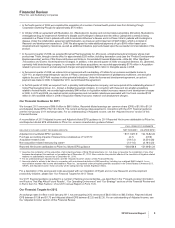Pfizer 2010 Annual Report Download - page 21
Download and view the complete annual report
Please find page 21 of the 2010 Pfizer annual report below. You can navigate through the pages in the report by either clicking on the pages listed below, or by using the keyword search tool below to find specific information within the annual report.
Financial Review
Pfizer Inc. and Subsidiary Companies
The discount rates used in the intangible asset valuations ranged from 9% to 17%, and the estimated cash flows were pro-
jected over periods extending up to 20 years or more. For IPR&D assets, the PTRS rates ranged from 4% to 90%. Within this
broad range, we recorded approximately $600 million of assets with a PTRS of up to 25%; approximately $500 million of assets
with a PTRS of 26% to 50%; approximately $500 million of assets with a PTRS of 51% to 75%; and approximately $12.2 billion
of assets with a PTRS above 75% (which includes Prevnar/Prevenar 13 for Infant and Adult). All of these judgments and esti-
mates can materially impact our results of operations.
For IPR&D assets, the risk of failure has been factored into the fair value measure and there can be no certainty that these assets
ultimately will yield a successful product. The nature of the biopharmaceutical business is high-risk and requires that we invest in a
large number of projects as a mechanism for achieving a successful portfolio of approved products. As such, it is likely that many of
the IPR&D assets will become impaired and be written off at some time in the future (also see the “Accounting Policies—Asset
Impairment Reviews—Long-Lived Assets” section of this Financial Review and Notes to Consolidated Financial Statements—
Note 3B. Other Significant Transactions and Events: Asset Impairment Charges).
•Other Matters, including Contingencies––In the ordinary course of business, Wyeth incurred liabilities for environmental, legal and tax
matters as well as guarantees/indemnifications. These matters may have included contingencies. Generally, contingencies are required
to be measured at fair value, if the acquisition-date fair value of the asset or liability arising from a contingency can be determined. If the
acquisition-date fair value of the asset or liability cannot be determined, the asset or liability would be recognized at the acquisition date
if both of the following criteria were met: (i) it is probable that an asset existed or that a liability had been incurred at the acquisition date
and (ii) the amount of the asset or liability can be reasonably estimated.
OEnvironmental Matters—In the ordinary course of business, Wyeth incurred liabilities for environmental matters such as remediation
work, asset retirement obligations, and environmental guarantees and indemnifications. Virtually all liabilities for environmental
matters, including contingencies, were measured at fair value and approximated $570 million as of the acquisition date.
OLegal Matters—Wyeth was involved in various legal proceedings, including product liability, patent, commercial, environmental,
antitrust matters and government investigations of a nature considered normal to its business, (see Notes to Consolidated Financial
Statements—Note 19. Legal Proceedings and Contingencies). Due to the uncertainty of the variables and assumptions involved in
assessing the possible outcomes of events related to these items, an estimate of fair value was not determinable. As such, these
contingencies were measured under the same “probable and estimable” standard previously used by Wyeth. Liabilities for legal
contingencies approximated $1.3 billion as of the acquisition date, which included the recording of additional adjustments of
approximately $260 million for legal matters that we intended to resolve in a manner different from what Wyeth had planned or
intended.
OTax Matters––In the ordinary course of business, Wyeth incurred liabilities for income taxes.Income taxes are exceptions to both the
recognition and fair value measurement principles associated with the accounting for business combinations. Liabilities for income
tax continue to be measured under the benefit recognition model as previously used by Wyeth (see Notes to Consolidated Financial
Statements––Note 1P. Significant Accounting Policies: Deferred Tax Assets and Income Tax Contingencies). Net liabilities for
income taxes approximated $23.7 billion as of the acquisition date, which included $1.8 billion for uncertain tax positions (not
including $300 million of accrued interest). The net tax liability included the recording of additional adjustments of approximately
$14.4 billion for the tax impact of fair value adjustments and $10.5 billion for income tax matters that we intended to resolve in a
manner different from what Wyeth had planned or intended. For example, because we planned to repatriate certain overseas funds,
we provided deferred taxes on Wyeth’s unremitted earnings, as well as on certain book/tax basis differentials related to investments
in certain foreign subsidiaries for which no taxes had been previously provided by Wyeth as it was Wyeth’s intention to permanently
reinvest those earnings and investments.
2010 Financial Report 19
























